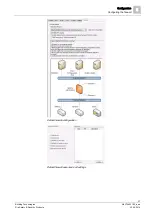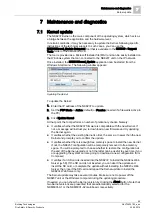
Configuration
6
Configuring the routing table
38
Building Technologies
A6V10403182_a_en
Fire Safety & Security Products
30.09.2014
Firewall source and destination addresses settings
Predefined TCP/UDP ports
TCP Port 51000 to 51064: SintesoWorks tool communications
TCP Port number 3001 (NK8000, 3001…3004 in multiple host configurations)
TCP Port 20500: NK8000 secure download
TCP Ports 20 and 21: NK8000 FTP download
UDP Port 161: Simple Network Management Protocol (SNMP on NK823x and
NK8237)
TCP Port 443: NK8000 Web Server (https)
TCP Port 4000: NK8000 control and service messages
TCP Port 502: default for Modbus (configurable on the Modbus Protocol node
in the Protocols folder)
UDP Port 47808 (hex BAC0): default for BACnet (configurable on the BACnet
Protocol node in the Protocols folder)
UDP Port 53:
traceroute
standard network diagnostics command
Note: If the BACnet UDP port is changed, the same changes should be applied in
the BACnet parameters of the NS8011 BACnet Driver node.
6.7
Configuring the routing table
Configuring the routing table
1. Select the NK8237 firewall node.
2. In the Routing tab, click the Add button to add a new route.
3. Configure the following parameters:
- Applying standard IP addressing concepts, enter Destination and Netmask
to describe the destination range on an external subnet.
For example, destination 192.168.2.0 and netmask 255.255.255.0 defines
any address in the range 192.168.2.0 to 254. Instead, destination
192.168.2.10 and netmask 255.255.255.0 defines the single IP address
192.168.2.10.
- Enter the IP address of the Gateway, on the same subnet, which can
provide connectivity for the destination subnets.
- If multiple routes are available for the same destination, use the Metric field
to indicate the cost (e.g. the number of devices along the network path) of






























